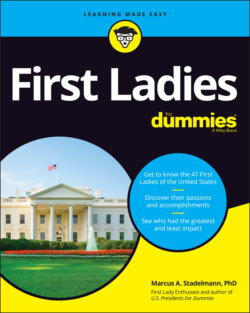Читать книгу First Ladies For Dummies - Marcus A. Stadelmann, Marcus A. Stadelmann PhD - Страница 27
Evaluating the First Ladies
ОглавлениеUnlike U.S. presidents, academics and the American public rarely evaluate First Ladies. It wasn’t until the 1980s that the Siena College Research Institute in New York established an academic survey to rate and rank First Ladies. The survey continues but isn’t taken often, usually only about once a decade. To this date, it has been conducted only five times since its inception in 1982. The most recent survey, discussed later in the chapter, was taken in 2014.
Keep in mind that times change and First Lady rankings reflect this. Early in U.S. history, First Ladies were mainly hostesses in and caretakers of the White House. Some even refused to do that and had their daughters step into their place. Only a few First Ladies mattered when it came to impacting policy making. They were Sarah Polk, Dolley Madison, and, of course, Abigail Adams. Not surprisingly, many First Ladies of the 19th century don’t rank very high in the survey. They just didn’t do much besides being a great White House hostess, if that. Keep in mind that this isn’t a negative thing; that is all that was expected of them, and if they had been more engaged, the American public may not have stood for it.
It wasn’t until the 20th century that stronger First Ladies emerged. They suddenly took their place next to the president and influenced policy making. Some were even quite public about it. Eleanor Roosevelt was the first First Lady who was actually publicly involved in policy making and openly conversed with the America public about her political stands and preferences.
Media scrutiny of First Ladies is also a recent phenomenon. During most of the 19th and 20th centuries, the media didn’t delve into the lives of First Ladies. Much of what we know, we get from letters written by First Ladies, their husbands, and their acquaintances, and even that isn’t much because often First Ladies would burn their correspondence when leaving office. It was considered taboo to report on the private lives of First Ladies — the public didn’t know much, if anything, about Eleanor Roosevelt’s live-in girlfriend or Helen Taft smoking cigarettes and playing cards with the boys. A president’s or First Lady’s private indiscretions were kept secret. This code of silence held well into the 20th century.
The Watergate scandal in the 1970s changed things. Suddenly, the media believed that it had an obligation to be a watchdog over the presidents and First Ladies. This new role allowed the media not only to check presidents for public mistakes and policy failures but also to report on First Ladies and their activities. This role for the media won’t change as long as juicy scandals continue to garner large audiences. Future First Ladies have to expect to have their lives scrutinized and any minor wrongdoing reported. Hillary Clinton found that out the hard way in 1993 with the Whitewater scandal, where the Clinton’s were accused of financial wrongdoings (see Chapter 18) and again in 2015, after her term as First Lady had ended in 2001, when the media reported on her using her private server for classified emails. Today, scrutiny of First Ladies does not even end after their terms have ended. Melania Trump ran into a similar problem when her nude photoshoot of 2000 was revealed during the 2016 campaign.
